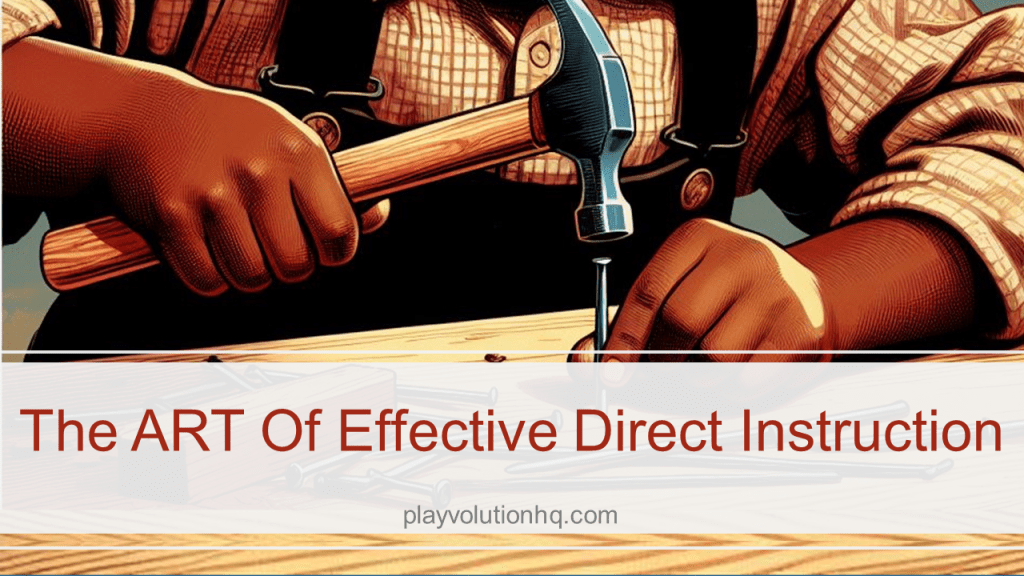
Table of Contents
Direct instruction with young children is highly effective when active, relevant, and timely to the learner. Alas, direct instruction often fails to meet those three criteria. Ask the tens of thousands of fidgeting children subjected to lectures and lessons on topics they are not interested in because an adult thinks said topics are essential.
How would you feel if I mandated you listen to a lecture on “How to Properly Use a Stapler: An OSHA-Approved Guide,” “The Impact of 12th Century Papal Decrees on Modern European Land Ownership,” or “The Evolution of Door Knob Manufacturing in Post-War Europe.” Unless you happen to be really into staplers, papal decrees, or door knobs, you’d probably tune out and fidget like kids do when topics they don’t find interesting are forced upon them.
Kids and adults tend to shy away from topics they find:
- Outside Their Interests Or Experiences
- Lacking Practical Application
- Overly Abstract Or Esoteric
- Dull Or Overly Technical
- Emotionally Or Psychologically Uncomfortable
- Overly Repetitive Or Redundant
Adults are more physiologically and cognitively able to force themselves to endure topics they find off-putting, but many still struggle to remain attentive and engaged. And adults are almost always free to get up and walk out if they choose, a luxury rarely provided to preschoolers.
That said, when thoughtfully deployed, direct instruction is a valuable tool. Thoughtful deployment means your direct instruction should be Active, Relevant, and Timely. Let’s take a closer look at those requirements:
Active
Direct instruction should be active. Young children are in-motion learners. For example, if a child is learning to pound in a nail, she should have a hammer in her hand. The reason for this is simple: we humans learn more efficiently when multiple sensory systems are engaged. When learned actively, new information, concepts, and skills stick in our brains.

Relevant
When lessons are connected to children’s real-life experiences and interests, they are more likely to see the value in learning and retain the information.
Direct instruction should be relevant to the learner. Trying to teach
a child interested in spiders about the wonders of broccoli is a
waste of everyone’s time. Learning is stickier when the learner
finds the topic fascinating, beneficial, or personally relevant. Luckily, young children are intensely curious and desire to know all about the world they live in. They will get to broccoli when they’re ready.

Timely
Timely instruction involves being responsive to children’s immediate needs and interests, which vary daily. A child interested in learning to tie her shows this morning may move on to dinosaurs by noon.
Direct instruction should occur promptly when a child is interested
in knowing more. For example, the best time to teach a child
interested in learning to draw a heart while making a get-well-soon card for grandma is when they express that. Wait too long,
and their interest is likely to wane.

A Table Of Comparison
Here’s a table showing ineffective vs. ART-based direct instruction examples:
| Aspect | Ineffective Direct Instruction | ART-Based Effective Direct Instruction |
|---|---|---|
| Active vs. Passive | A teacher gives a 10-minute lecture on how to use a hammer before letting children try. | A child picks up a hammer, and the teacher gives quick, hands-on guidance as they attempt to use it. |
| Relevance | A teacher gives a long lecture on how pulleys work without any physical examples. | A child finds a dandelion and asks about the fuzzy seeds—the teacher explains in that moment. |
| Timeliness | A teacher delays showing a child how to tie their shoes, waiting until “shoe-tying week” in the curriculum. | A child asks how to tie their shoes, and the teacher shows them immediately while their interest is high. |
| Engagement | A teacher expects kids to sit still while discussing why birds migrate. | While outside, children watch a flock of birds, and the teacher briefly explains migration as they observe it. |
| Retention | A teacher gives a long lecture on how pulleys work, without any physical examples. | Kids experiment with pulleys on the playground, and the teacher offers short explanations as they try different setups. |
Other Tips
In addition to being Active, Relevant, and Timely, effective direct instruction should also follow the principles of what I like to call Sushi Learning—it should be bite-sized. Keep the instruction short, simple, and focused.
Young children are naturally curious, but their attention spans are limited—especially if the information doesn’t immediately connect to their interests or experiences. Long-winded explanations, complex language, or tangents can quickly lead to frustration or disengagement. Instead, instruction should be delivered in small, bite-sized moments, ensuring that children absorb and apply the information without feeling overwhelmed. Like a perfectly portioned piece of sushi, each learning moment should be just enough to satisfy curiosity and invite further exploration without overloading the child.
For example, if a child struggles to zip their coat, the most effective instruction isn’t a step-by-step lecture on zipper mechanics. Instead, a caregiver might offer a quick, focused tip—“Hold the bottom steady while you pull up”—and let the child try again. If they need more help, guidance can be layered in gradually rather than front-loading too much information at once.
Similarly, if a child is fascinated by a butterfly fluttering nearby, a lengthy explanation of metamorphosis isn’t necessary. A simple, well-timed statement—“That butterfly used to be a caterpillar!”—can spark curiosity and invite more questions, keeping the exchange natural and engaging.
Direct Instruction Wrap-Up
Active, relevant, and timely direct instruction leverages young children’s natural inclinations and developmental stages, making learning more engaging, meaningful, and effective. By incorporating these elements, educators can create a rich educational experience that lays a strong foundation for future academic success.
Related Resource
Here are some free PDF handouts related to this topic:
Contribute content to Playvolution HQ
Brought to you by Explorations Early Learning
Browse Trainings

Author
Jeff Johnson is an early learning trainer, podcaster, and author who founded Explorations Early Learning, Playvolution HQ, and Play Haven.
In-Person And Online Training
Learn how to book an in-person or online training for your organization on these early learning topics.
Support The Site
I participate in the Amazon Services LLC Associates Program, an affiliate advertising program designed to provide a means for me to earn fees
by linking to Amazon.com and affiliate sites.
Thanks To Our Patrons
This post was made possible by patrons like these, who generously fund our work:
Supporters
Lissadell Greene Stephanie Goloway Jennifer Stark
Lagina Kozak Michelle Hankins
Marie Messinger Tamara L. Lakin
Fans
Jen Flemming Lizz Nolasco Cynthia J Bays
Susan Warner Kelly Sigalove Shawn Wolf
Vittoria Jimerson Codee Gilbert Wendy Tedford
Monica Morrell Pam Soloman Melissa Franklin
Teresa Watson Erika Felt Autumn Peele
Melissa Taylor Jahmeela Robinson Stacie Manning
Amber Maurina Terra Calamari Anne Jackson
Lagina Kozak Samantha Yeager-Cheevers
Elizebeth McCoy Sammy Cousens Ellen Cogan





Leave a Reply